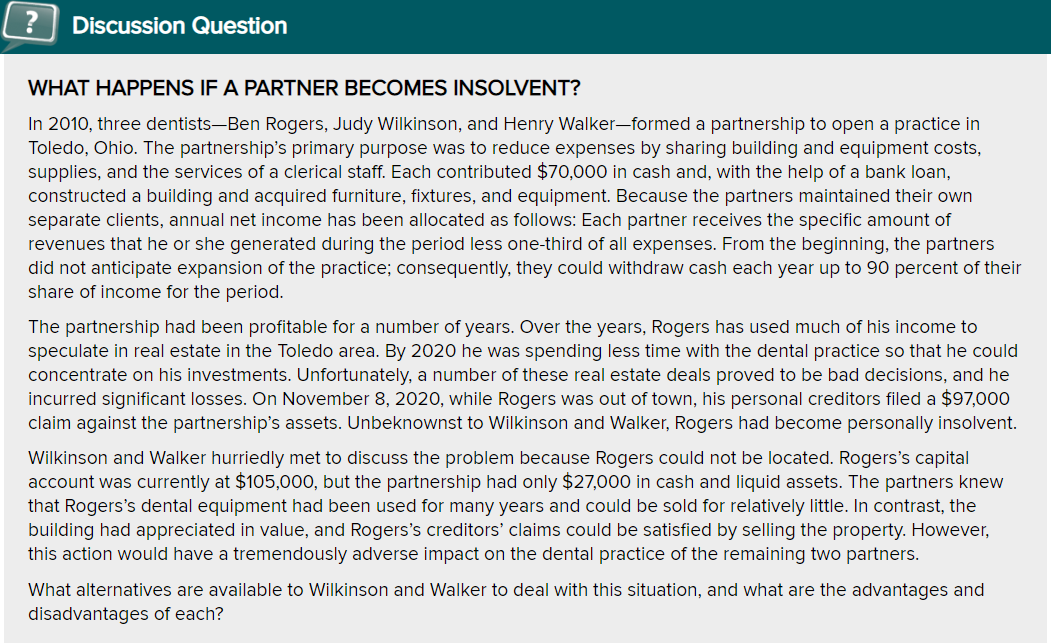What alternatives are available to Wilkinson and Walker to deal with this situation, and what are the advantages and disadvantages of each?
What alternatives are available to Wilkinson and Walker to deal with this situation, and what are the advantages and disadvantages of each?
SWFT Essntl Tax Individ/Bus Entities 2020
23rd Edition
ISBN:9780357391266
Author:Nellen
Publisher:Nellen
Chapter1: Introductin To Taxation
Section: Chapter Questions
Problem 9P
Related questions
Question
What alternatives are available to Wilkinson and Walker to deal with this situation, and what are the advantages and disadvantages of each?

Transcribed Image Text:?
Discussion Question
WHAT HAPPENS IF A PARTNER BECOMES INSOLVENT?
In 2010, three dentists-Ben Rogers, Judy Wilkinson, and Henry Walker-formed a partnership to open a practice in
Toledo, Ohio. The partnership's primary purpose was to reduce expenses by sharing building and equipment costs,
supplies, and the services of a clerical staff. Each contributed $70,000 in cash and, with the help of a bank loan,
constructed a building and acquired furniture, fixtures, and equipment. Because the partners maintained their own
separate clients, annual net income has been allocated as follows: Each partner receives the specific amount of
revenues that he or she generated during the period less one-third of all expenses. From the beginning, the partners
did not anticipate expansion of the practice; consequently, they could withdraw cash each year up to 90 percent of their
share of income for the period.
The partnership had been profitable for a number of years. Over the years, Rogers has used much of his income to
speculate in real estate in the Toledo area. By 2020 he was spending less time with the dental practice so that he could
concentrate on his investments. Unfortunately, a number of these real estate deals proved to be bad decisions, and he
incurred significant losses. On November 8, 2020, while Rogers was out of town, his personal creditors filed a $97,000
claim against the partnership's assets. Unbeknownst to Wilkinson and Walker, Rogers had become personally insolvent.
Wilkinson and Walker hurriedly met to discuss the problem because Rogers could not be located. Rogers's capital
account was currently at $105,000, but the partnership had only $27,000 in cash and liquid assets. The partners knew
that Rogers's dental equipment had been used for many years and could be sold for relatively little. In contrast, the
building had appreciated in value, and Rogers's creditors' claims could be satisfied by selling the property. However,
this action would have a tremendously adverse impact on the dental practice of the remaining two partners.
What alternatives are available to Wilkinson and Walker to deal with this situation, and what are the advantages and
disadvantages of each?
Expert Solution
This question has been solved!
Explore an expertly crafted, step-by-step solution for a thorough understanding of key concepts.
This is a popular solution!
Trending now
This is a popular solution!
Step by step
Solved in 2 steps

Recommended textbooks for you


College Accounting, Chapters 1-27 (New in Account…
Accounting
ISBN:
9781305666160
Author:
James A. Heintz, Robert W. Parry
Publisher:
Cengage Learning



College Accounting, Chapters 1-27 (New in Account…
Accounting
ISBN:
9781305666160
Author:
James A. Heintz, Robert W. Parry
Publisher:
Cengage Learning


College Accounting, Chapters 1-27
Accounting
ISBN:
9781337794756
Author:
HEINTZ, James A.
Publisher:
Cengage Learning,
